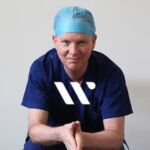
Skilful plastic surgery can now re-shape a face in a variety of ways and many aspects can be improved using modern techniques, even when there’s significant ageing. This doesn’t mean that we can fix everything however.
A facelift is used to restore, as far as possible, the youthful and natural appearance of the face and neck. The key to a successful facelift is careful and expert evaluation. When an accurate diagnosis of the individual pattern of ageing is made, the surgeon can make the optimal operative plan. Then, if the procedure is performed to high standards, the result will usually be successful.
Although a facelift can make a big difference to your appearance, there are some things which are challenging to fix. One of these is when the skin is not of good quality. For example, if someone has a lot of wrinkles caused by sun damage and the skin is very loose – especially in the neck – it’s challenging. We don’t (yet) have the ability to transform someone with really bad skin into someone with great skin. The best candidates for facelift surgery have great skin which is healthy, without much sun damage, and not especially wrinkled. This is because if you have naturally good skin, restoring the contour and correction of sagging can be pretty effective and the end result is really good. When the skin is of poor quality though, the facial shape can certainly be changed. However, some of the wrinkling and expression pattern remains and in some areas the skin seems to persist in sagging a little, which limits the result.
So, what do we feel we can’t fix in the face?
The answer is, quite a lot. First of all, if someone is determined to have a face that’s nothing like their own, then the changes they are hoping for are not appropriate or realistic.
When this is the case, there may be an element of a psychological disorder, like obsessive compulsive disorder or body dysmorphic disorder. Conditions like these can be distressing for patients and as surgeons, we can recognise this and try to help them as best we can. Though we are not qualified or able to correct this type of disorder, we always hope that after working with these patients, they will take our advice and seek professional advice for their condition.
With the face itself, it’s generally possible to change aspects of the facial skeleton so that we can restore volume to the face where its deficient. The aim is to elevate structures that are sagging or displaced and re-position them. Many patients also take advantage of non-surgical treatments, like cosmetic injectables, laser skin treatments or light therapies. And of course, quality skincare products can help to improve the quality of the skin.
Skin improvement, though, is usually an ongoing process. As I said before, it’s not possible to make very poor skin very good, but it can be improved to a certain extent. So, in terms of what we can’t fix, we generally have to work with the face we have and hopefully devise an intelligent plan that offers a significant degree of improvement.
I should also mention that there are many concerns that surgery can’t fix – if being fixed means making a big change or improvement.
There are some medical problems that affect the face and various inherited disorders such as collagen or connective tissue disorders, which affect the face and can’t be fixed. Some people inherit the tendency to form very poor scars called keloid scarring. Unfortunately, this type of scarring can’t always be fixed and so it must be recognised as a risk.
Medical conditions such as thyroid disorders can cause swelling of the face and some people have very puffy faces or intermittent swelling. If there are volume changes in the face, it can cause distressing changes to the facial appearance due to fluid retention or endocrine disorders. There may be medical treatment for these, but unfortunately surgical treatment is not possible and disappointment looms if surgery is attempted for intermittent swelling problems.
It’s important to be realistic about what can be fixed surgically and what can be improved by other means. Accepting what can’t be fixed or improved is crucial at the surgical planning stage, so that there is no disappointment at the end of the process. You can read more about this in my post ‘Great expectations and how to manage them’.





